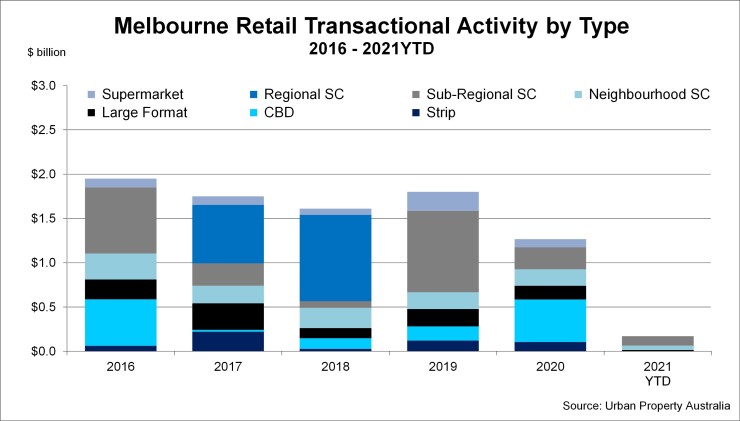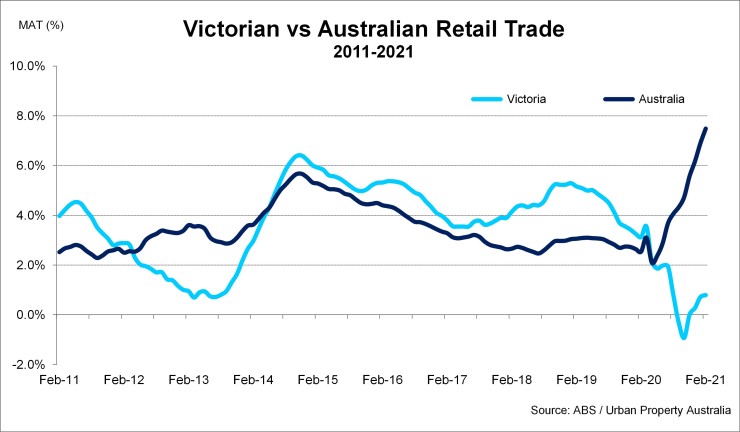Q1 2021 – Melbourne Retail Market
April 12th 2021 | , Urban Property Australia
Investment activity in the Victorian retail property sector in 2020 totalled $1.1 billion, the lowest annual transactional level since 2012;
Vacancy rates of Melbourne’s prime retail strips rose to 20-year highs as a result of retailers entering administration and store rationalisation;
Victorian retail turnover contracted for the first time on record last year as the full effect of the hard lockdowns was fully borne, however strong economic gains of 2021 have seen retail trade bounce back this year.
Retail Market Summary
For the first time on record, Victorian retail trade contracted last year as the influence of the Victorian lockdown reduced consumer spending patterns, however strong economic gains of 2021 have seen retail trade bounce back this year. With the lockdown having forced many occupiers to permanently close, the outlook for the sector is likely to be influenced by consumer confidence and the impact of fiscal support tailing off.
Sales Volume/Yields
Investment activity in the Victorian retail property sector in 2020 totalled $1.1 billion, the lowest annual transactional level since 2012 reflecting the subdued buyer sentiment of the sector at present. Over 2020, Urban Property Australia research revealed that domestic unlisted funds and syndicates accounted for 55% of the volume of Victorian retail property. Offshore groups purchased 24% of retail property assets sold last year with private investors having accounted for 21% of retail properties sold in 2020. In terms of sales by retail asset type, CBD-based retail assets accounted for 43% of all Victorian retail sales followed by Neighbourhood shopping centres which accounted for 16%. Transactional activity in the retail sector has been limited in 2021 to date with only $450 million of Victorian-based retail assets sold.
Yields have softened for the majority of retail asset types through 2020 affected by the uncertainty of the behaviour of consumers post COVID and the growth of e-commerce. Over the 12 months to March 2021, yields of CBD retail assets have expanded the greatest, impacted by the closure of Australia’s international borders and slow return of employees to CBD workplaces followed by yields of Regional shopping centres which have expanded by around 150 basis points. In contrast, yields for both large format retail assets and Neighbourhood shopping centres have held relatively steady in the 12 months to March 2021.

Demand
Over the year to February 2021, annual retail trade in Victoria grew by 0.8%, having actually contracted between September and October 2020. The contrast of the trend of Australian retail trade and Victorian retail trade highlights the impact of the Victorian lockdowns in 2020 and how precarious the sector remains. Over 2020, around 900 stores were closed, 200% higher than 2019 with retailer rationalisation and retailers falling into voluntary administration prominent.
Although retail trade grew in Victoria has recovered in 2021, the variance of the performance of the individual retail sub-sectors illustrates the impact of the pandemic with retail trade for cafes and restaurants 49% lower than levels last year whereas retail trade for household goods has increased by 12%.
Online retail trade in Australia continues to gradually take a larger share of overall spending. According to the ABS, as at December 2020, online sales made up 9% of total retail sales with Australian online sales having grown by 54% over the year. Australian consumers have spent approximately $44 billion

Retail Strips
Total vacancy of Melbourne’s prime retail strips has risen to all-time highs with around 15% of all shops vacant. The vacancy levels of both Bridge Road, Richmond and Acland Street, St Kilda are both higher than 20% for the first time with the precincts impacted by Melbourne’s lockdown and the closure of Australia’s international borders.
There remains a significant level of uncertainty going into 2021. The outlook for the sector is likely to be influenced by consumer confidence and the impact of fiscal support tailing off and the possibility of future lockdowns as recently experienced in Victoria with the five-day “circuit-breaker” lockdown in February 2021.
With the lockdown having forced many occupiers to permanently close, looking ahead Urban Property Australia expects that there will be downward pressure on rents which may fall by around 20% in order for landlords to attract different types of occupiers post-pandemic.
Copyright © 2021 by Urban Property Australia All rights reserved. No part of this publication may be reproduced in any form, by microfilm, xerography, electronically or otherwise, or incorporated into any information retrieval system, without the written permission of the copyright owner.



